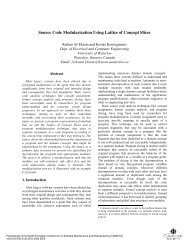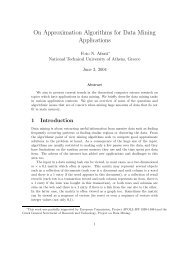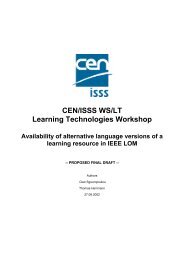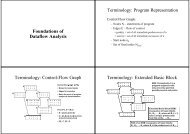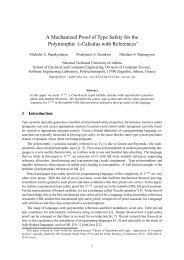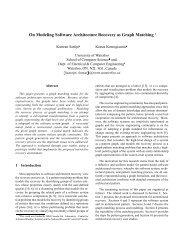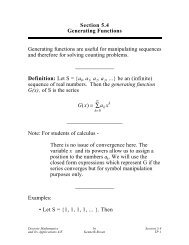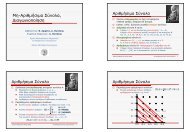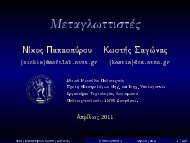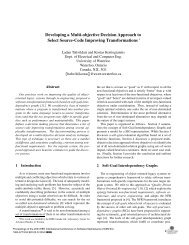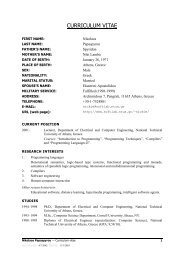Manual
Manual
Manual
Create successful ePaper yourself
Turn your PDF publications into a flip-book with our unique Google optimized e-Paper software.
Chapter 3: Bison Grammar Files 47<br />
• Choose one of those types for each symbol (terminal or nonterminal) for which semantic<br />
values are used. This is done for tokens with the %token Bison declaration (see<br />
Section 3.7.2 [Token Type Names], page 54) and for groupings with the %type Bison<br />
declaration (see Section 3.7.5 [Nonterminal Symbols], page 56).<br />
3.5.3 Actions<br />
An action accompanies a syntactic rule and contains C code to be executed each time an<br />
instance of that rule is recognized. The task of most actions is to compute a semantic value<br />
for the grouping built by the rule from the semantic values associated with tokens or smaller<br />
groupings.<br />
An action consists of braced code containing C statements, and can be placed at any<br />
position in the rule; it is executed at that position. Most rules have just one action at the<br />
end of the rule, following all the components. Actions in the middle of a rule are tricky and<br />
used only for special purposes (see Section 3.5.5 [Actions in Mid-Rule], page 48).<br />
The C code in an action can refer to the semantic values of the components matched<br />
by the rule with the construct $n, which stands for the value of the nth component. The<br />
semantic value for the grouping being constructed is $$. Bison translates both of these<br />
constructs into expressions of the appropriate type when it copies the actions into the<br />
parser file. $$ is translated to a modifiable lvalue, so it can be assigned to.<br />
Here is a typical example:<br />
exp: ...<br />
| exp ’+’ exp<br />
{ $$ = $1 + $3; }<br />
This rule constructs an exp from two smaller exp groupings connected by a plus-sign token.<br />
In the action, $1 and $3 refer to the semantic values of the two component exp groupings,<br />
which are the first and third symbols on the right hand side of the rule. The sum is stored<br />
into $$ so that it becomes the semantic value of the addition-expression just recognized by<br />
the rule. If there were a useful semantic value associated with the ‘+’ token, it could be<br />
referred to as $2.<br />
Note that the vertical-bar character ‘|’ is really a rule separator, and actions are attached<br />
to a single rule. This is a difference with tools like Flex, for which ‘|’ stands for either “or”,<br />
or “the same action as that of the next rule”. In the following example, the action is<br />
triggered only when ‘b’ is found:<br />
a-or-b: ’a’|’b’ { a_or_b_found = 1; };<br />
If you don’t specify an action for a rule, Bison supplies a default: $$ = $1. Thus, the<br />
value of the first symbol in the rule becomes the value of the whole rule. Of course, the<br />
default action is valid only if the two data types match. There is no meaningful default<br />
action for an empty rule; every empty rule must have an explicit action unless the rule’s<br />
value does not matter.<br />
$n with n zero or negative is allowed for reference to tokens and groupings on the stack<br />
before those that match the current rule. This is a very risky practice, and to use it reliably<br />
you must be certain of the context in which the rule is applied. Here is a case in which you<br />
can use this reliably:



